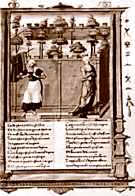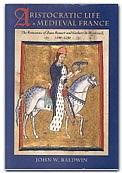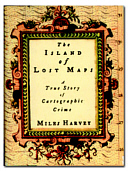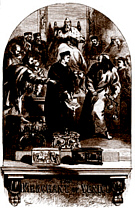

|
|
Photos courtesy Walters Art
Museum, Baltimore, MS. W. 143 Folio LR
|
|
Roman de la Rose is an odd but highly significant text.
Its first
4,058 lines were composed around 1230 by Guillaume de Lorris,
about whom not much more is known than his name. This section is
a dreamy and unfinished allegory about the wooing of a maiden. It
has been described as a handbook on courtly love. About 50 years
later, a poet named Jean de Meun decided to finish the poem, and
appended a large tail to a small dog--adding more than 18,000
lines that are a virtual encyclopedia of information and opinions
on a wide range of topics contemporary to the 13th century:
astronomy, the newly emergent bourgeois class in medieval France,
the hoarding of money, the duty of people to increase and
multiply, and a variety of other subjects. The poem was copied so
many times during the next three centuries that around 300 copies
still exist in museums around the world.
When Nichols learned in 1997 that his colleagues in France
planned to digitize some of the manuscripts, he suggested moving
part of the project to the United States. "I knew the Eisenhower
Library at Hopkins had just gotten a new digital camera that was
a much higher resolution than anything these guys could afford,"
he recalls, and he hoped to gain access to the originals held at
the Walters, Morgan, and Bodleian.
No model existed for creating digital manuscripts of this sort,
so in November 1998, financed by funding from the Samuel H. Kress
Foundation, medieval scholars and experts in digital technology
convened a colloquium to discuss how to convert manuscript pages
to pixels. The three manuscripts were scanned, and Brian
Harrington of the Eisenhower Library's Digital Knowledge Center
and Elizabeth Brown of the library's catalog department created
an on-line prototype titled "Roman de la Rose: Digital
Surrogates
of Three Manuscripts."
A few months ago, the project received an additional $65,000 from
the Kress and Gladys Krieble Delmas foundations for the second
phase of the project, which will develop more sophisticated
search capabilities, improve navigation and display of the
manuscripts, and create a database of Old French variant
spellings.
Students and scholars who wish to study the three manuscripts can
access the digital images via the World Wide Web, leaving the
originals undisturbed. They also can compare manuscripts, which
vary not just in their decorative elements, but in text. Nichols
says that different scribes inserted different interpolations:
"The scribe decides, 'This section reminds me of a story, so I'm
just going to add this.' So he'll go on for 50 or 60 lines,
adding another anecdote. That would seem trivial, but if, for
example, [the addition] were a moralizing anecdote, that can
change the way in which the whole manuscript was being read. We
can study the changes and this can tell us how this thing was
being read, and how something in the Middle Ages retained its
popularity. This helps us understand cultural movements."
If this prototype succeeds, the Eisenhower and Morgan libraries
would like to add other manuscripts. Nichols, who admits the
project has grown way beyond his initial expectations, smiles and
says, "You might describe this as the enthusiasm of running for
office followed by the sinking feeling you get when you're
actually in office. The more we got into it, we realized this is
a much bigger project than we thought. We bit off more than we
could chew, and now we're chewing it." --DK
A new take on Shylock
For most of its 400-year existence, Shakespeare's The Merchant
of
Venice has been regarded by readers, audiences, and critics
alike
as a comedy pitting Christian love against Jewish venality, mercy
versus vengeance, and moral paradigms in conflict. Shylock, a
Jewish money-lender, demands a pound of flesh from Antonio, a
debtor in default. Robert Schneider '74 begs to differ.
|














